
A priest is a religious leader authorized to perform the sacred rituals of a religion, especially as a mediatory agent between humans and one or more deities. They also have the authority or power to administer religious rites; in particular, rites of sacrifice to, and propitiation of, a deity or deities. Their office or position is the priesthood, a term which also may apply to such persons collectively. A priest may have the duty to hear confessions periodically, give marriage counseling, provide prenuptial counseling, give spiritual direction, teach catechism, or visit those confined indoors, such as the sick in hospitals and nursing homes.

Proserpina or Proserpine is an ancient Roman goddess whose cult, myths and mysteries were combined from those of Libera an early Roman goddess of wine. In Greek she is known as Persephone and her mother is Demeter, goddesses of grain and agriculture. The originally Roman goddess Libera was daughter of the agricultural goddess Ceres and wife to Liber, god of wine and freedom. In 204 BC, a new "Greek-style" cult to Ceres and Proserpina as "Mother and Maiden" was imported from southern Italy, along with Greek priestesses to serve it, and was installed in Libera and Ceres' temple on Rome's Aventine Hill. The new cult and its priesthood were actively promoted by Rome's religious authorities as morally desirable for respectable Roman women, and may have partly subsumed the temple's older, native cult to Ceres, Liber and Libera; but the new rites seem to have functioned alongside the old, rather than replaced them.

Vesta is the virgin goddess of the hearth, home, and family in Roman religion. She was rarely depicted in human form, and was often represented by the fire of her temple in the Forum Romanum. Entry to her temple was permitted only to her priestesses, the Vestals, who tended the sacred fire at the hearth in her temple. As she was considered a guardian of the Roman people, her festival, the Vestalia, was regarded as one of the most important Roman holidays. During the Vestalia matrons walked barefoot through the city to the sanctuary of the goddess, where they presented offerings of food. Such was Vesta's importance to Roman religion that hers was one of the last republican pagan cults still active following the rise of Christianity until it was forcibly disbanded by the Christian emperor Theodosius I in AD 391.
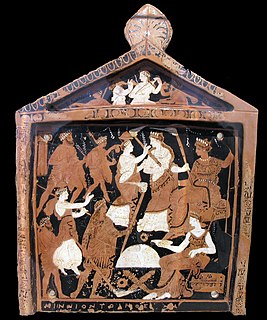
The Eleusinian Mysteries were initiations held every year for the cult of Demeter and Persephone based at the Panhellenic Sanctuary of Eleusis in ancient Greece. They are the "most famous of the secret religious rites of ancient Greece". Their basis was an old agrarian cult, and there is some evidence that they were derived from the religious practices of the Mycenean period. The mysteries represented the myth of the abduction of Persephone from her mother Demeter by the king of the underworld Hades, in a cycle with three phases: the descent (loss), the search, and the ascent, with the main theme being the ascent (άνοδος) of Persephone and the reunion with her mother. It was a major festival during the Hellenic era, and later spread to Rome. Similar religious rites appear in the agricultural societies of Near East and in Minoan Crete.

In ancient Roman religion, Ceres was a goddess of agriculture, grain crops, fertility and motherly relationships. She was originally the central deity in Rome's so-called plebeian or Aventine Triad, then was paired with her daughter Proserpina in what Romans described as "the Greek rites of Ceres". Her seven-day April festival of Cerealia included the popular Ludi Ceriales. She was also honoured in the May lustratio of the fields at the Ambarvalia festival, at harvest-time, and during Roman marriages and funeral rites.

Bona Dea was a goddess in ancient Roman religion. She was associated with chastity and fertility in Roman women, healing, and the protection of the state and people of Rome. According to Roman literary sources, she was brought from Magna Graecia at some time during the early or middle Republic, and was given her own state cult on the Aventine Hill.
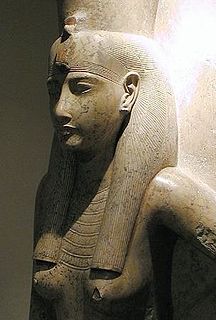
Mut, also known as Maut and Mout, was a mother goddess worshipped in ancient Egypt. Her name literally means mother in the ancient Egyptian language. Mut had many different aspects and attributes that changed and evolved a lot over the thousands of years of ancient Egyptian culture.

In ancient Roman religion, Roma was a female deity who personified the city of Rome and more broadly, the Roman state. She embodied Rome in complex ways and symbolized the ideal woman in society. Roman political and religious ideas were portrayed through Roma in the different forms of media: coins, sculptures and designs on architecture. Roma was a construction of Roman state patronage. Though her depictions have been influenced by other goddesses at the time, such as Minerva and Tyches in general, Roma stood out as a symbol of Rome.
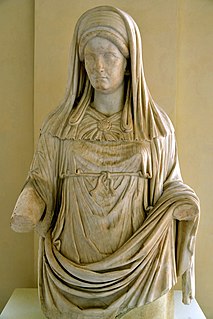
In ancient Rome, the Vestals or Vestal Virgins were priestesses of Vesta, goddess of the hearth. The college of the Vestals was regarded as fundamental to the continuance and security of Rome. These individuals cultivated the sacred fire that was not allowed to go out. Vestals were freed of the usual social obligations to marry and bear children and took a 30-year vow of chastity in order to devote themselves to the study and correct observance of state rituals that were forbidden to the colleges of male priests.

Ancient Greek religion encompasses the collection of beliefs, rituals, and mythology originating in ancient Greece in the form of both popular public religion and cult practices. These groups varied enough for it to be possible to speak of Greek religions or "cults" in the plural, though most of them shared similarities.

A flamen was a priest of the ancient Roman religion who was assigned to one of eighteen deities with official cults during the Roman Republic. The most important three were the flamines maiores, who served the important Roman gods Jupiter, Mars, and Quirinus. The remaining twelve were the flamines minores. Two of the minores cultivated deities whose names are now unknown; among the others are deities about whom little is known other than the name. During the Imperial era, the cult of a deified emperor also had a flamen.
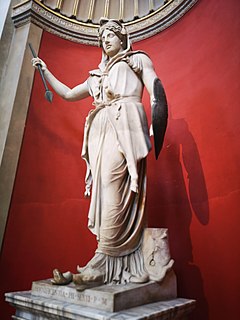
Juno is an ancient Roman goddess, the protector and special counsellor of the state. A daughter of Saturn, she is the wife of Jupiter and the mother of Mars, Vulcan, Bellona and Juventas. She is the Roman equivalent of Hera, queen of the gods in Greek mythology; like Hera, her sacred animal was the peacock. Her Etruscan counterpart was Uni, and she was said to also watch over the women of Rome. As the patron goddess of Rome and the Roman Empire, Juno was called Regina ("Queen") and was a member of the Capitoline Triad, centered on the Capitoline Hill in Rome; it consisted of her, Jupiter, and Minerva, goddess of wisdom.

Hieros gamos or Hierogamy is a sacred marriage that plays out between a god and a goddess, especially when enacted in a symbolic ritual where human participants represent the deities.

The Forest House is a fantasy novel by American writers Marion Zimmer Bradley and Diana L. Paxson, though the latter is uncredited by the publisher. It is a prequel to Bradley's Arthurian novel The Mists of Avalon.

The Temple of Vesta, or the aedes, is an ancient edifice in Rome, Italy. The temple is located in the Roman Forum near the Regia and the House of the Vestal Virgins. The Temple of Vesta housed Vesta's holy fire, which was a symbol of Rome's safety and prosperity. The temple's most recognizable feature is its circular footprint. Since the worship of Vesta began in private homes, the architecture seems to pay homage to the architecture of early Roman homes. The temple used Greek architecture with Corinthian columns, marble, and had a central cella. The surviving structure indicates that there were twenty Corinthian columns built on a podium fifteen meters in diameter. The roof probably had a vent at the apex to allow smoke to release.
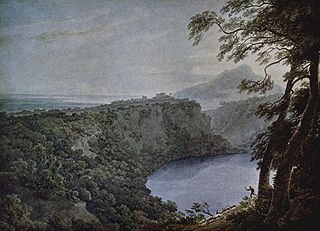
Diana Nemorensis, also known as "Diana of the Wood", was an Italic form of the goddess who became Hellenised during the fourth century BC and conflated with Artemis. Her sanctuary was to be found on the northern shore of Lake Nemi beneath the cliffs of the modern city Nemi. This lake is referred to by poets as speculum Dianae – "Diana's Mirror"; by the town of Aricia which was situated about three miles off, at the foot of the Albanus Mons, the Alban Mount, and separated by a steep descent from the lake, which lies in a small crater-like hollow on the mountainside.
Hiereiai was the title of the female priesthood or priestesses in ancient Greece, being the equivalent of the male title Hierei. Ancient Greece had a number of different offices in charge of worship of gods and goddesses, and both women and men functioned as priests. While there were local variations depending on cult, the Hiereiai had many similarities across ancient Greece.
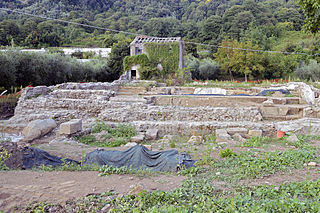
The Temple of Diana Nemorensis was an ancient Roman sanctuary erected around 300 BC and dedicated to the goddess Diana. The temple was situated on the northern shore of Lake Nemi beneath the cliffs of the modern city Nemi. It was a famous place of pilgrimage in the Italian peninsula. The temple complex covered an area of 45000 square meters.
Sacerdos Cereris, sacerdos Cerealis or sacerdos Cereris publica was the title of the Priestess of the goddess Ceres in Ancient Rome. It was one of two Roman state cults to include female priests.
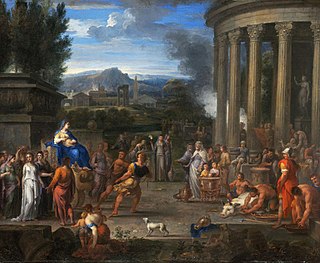
The Priestess of Hera at Argos was the High Priestess of the Goddess Hera, the protective city deity of Ancient Argos, on the Heraion of Argos in Argos.















